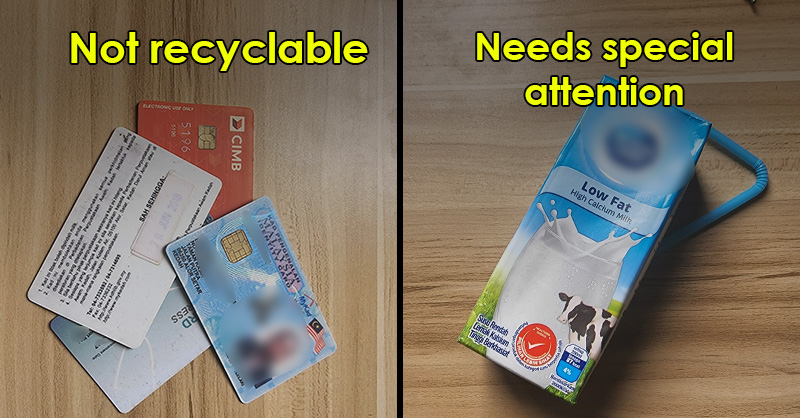7 common items Malaysians are recycling wrongly

- 153Shares
- Facebook146
- Twitter1
- Email1
- WhatsApp5
Growing up in 1990s Malaysia, you might be familiar with the recycling song:
“Coklat untuk kaca; biru kertas punya; tin untuk jingga, dan plastik juga!”
In hindsight, that’s a pretty memorable guide to our recycling system, where our recycling bins come in three colors: blue for paper waste, brown/chocolate for glass waste, and orange for cans and plastics. Seems simple enough to follow… or is it?

According to a survey done by Zero Waste Malaysia (ZWM) – a non-profit organization that advocates for sustainable development and living – around HALF of Malaysians are not quite sure whether the trash they have lying around the house are recyclable or not. To solve this problem, they recently came out with an interesting concept: an interactive online encyclopedia of trash, called Trashpedia.
“From a ZWM public survey (almost 7,000 responses) conducted in April 2022, 50% of respondents were confused about the recyclability of common household items, ZWM co-founder Khor Sue Yee believes the interactive Trashpedia webpage will encourage and empower Malaysians to care for the environment, practice a zero-waste lifestyle from the comfort of their own homes, and build a waste-free and sustainable future for Malaysia.” – excerpt from Zero Waste Malaysia’s press release.
This encyclopedia lists down some common types of household trash and tells us whether we can recycle them, and if not, offers zero-waste alternatives whenever possible. We’re all for interactive websites, so naturally we checked it out… and were shook at some of the entries. Here are some of the more interesting ones:
1. Food containers
There are two entries for this one. The first one is the clear clamshell food containers. You know, the one that you sometimes get your kuih or fruits in? It looks like plastic, but Trashpedia deems it unrecyclable for some reason, as the recommendation is to put these in the general bin.

A separate entry lists down types of food containers, and only the plastic ones can be recycled. Take off labels (if any), clean, and dry them before putting them in the recycling bin.

Alternative recommendations: Either go nude and buy unpackaged fruits and snacks, or bring your own container for takeaway.
2. Milk/juice cartons
Although it looks like paper, you don’t throw these in the paper bin: the outer shell is paperboard, while the inner lining is a mix of plastic and aluminum. Most of these cartons are usually Tetra Pak, so they’re recyclable, although it needs a bit more effort. To recycle, rinse the cartons out, flatten them, and send them off to a recycling center or a Tetra Pak drop off point – you can find the nearest one through this link.

Alternative recommendations: Trashpedia suggests going for alternatives with reusable containers, or make your own. Uh.
3. Cigarette boxes (and cigarettes)
This writer is actually guilty of chucking whole cigarette boxes into the paper bin, but apparently the inner lining of the boxes have aluminum on them, and therefore aren’t recyclable. Free the box from the lining and outer plastic, and dispose of them at a community recycling center.

Alternative recommendation: None were given.
4. Staples (?)
Yep, those little wire things that connect paper together. Apparently, some of them can be recycled if they’re made of metal, while those made of a metal/plastic mix can’t. You can tell them apart by using a magnet: if it sticks, it’s good to recycle. Collect a bunch of them before disposing.

Alternative recommendations: Use a stapleless stapler (yes, that’s a thing), or a reusable paper clip instead.
5. Credit cards/bank cards
Although they look like plastic, they’re actually made of polyvinyl chloride, a kind of plastic that’s hard to recycle. So this one goes into the normal trash bin.

Alternative recommendation: Trashpedia suggests shopping sustainably, by only applying for cards that are truly necessary.
6. C0v1d test kits
Surprisingly, only the paper boxes and the leaflets inside can be recycled: the rest should be sealed in the provided bag and disposed in the normal bin.

Alternative recommendation: None were given.
7. Keropok packaging
Although these look like plastic, the packaging often have aluminum mixed in them as well, making them unrecyclable. These should be thrown in the regular bin.

Alternative recommendations: Trashpedia recommends buying snacks in bulk (less packaging), making your own snacks, or opting for snacks that come in biodegradable or natural packaging, like rice paper or leaves.
Ehh… who knew recycling can be so tricky?
Well, these are just some of the more surprising things we found while browsing the Trashpedia for fun. If you’re interested to look at other kinds of trash – they currently list about 101 types of trash for now – you should really check them out through the links we posted throughout the article. A feature we kinda liked personally is the little bits of copywriting that goes into each type of trash, like this one for phone cases:

For now, the site is only in English, but there’s plans to add more languages (Malay, Chinese, and Tamil) by October and more trash soon, so we’ll be waiting eagerly for that to happen.
- 153Shares
- Facebook146
- Twitter1
- Email1
- WhatsApp5
